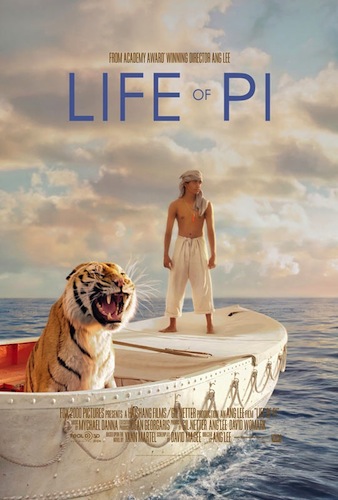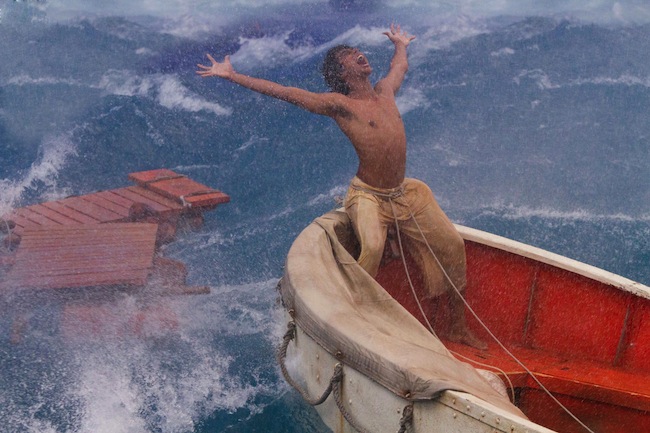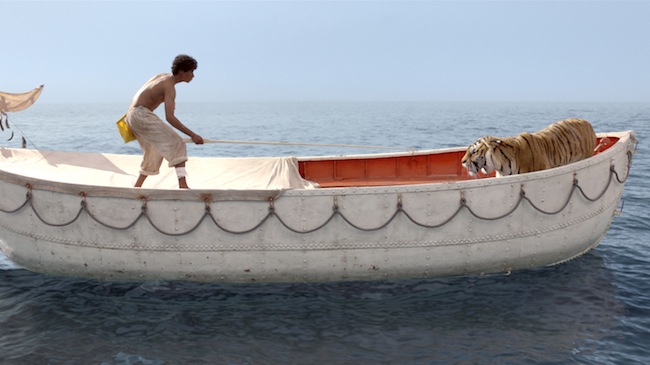
There is no question that director Ang Lee has once again turned out a visual stunner of a film in his adaptation of Yann Martel’s 2001 novel LIFE OF PI. Whether it’s the gorgeous seascapes Lee creates to tell this shipwrecked survival story or the incredibly seamless use of animals – real, animatronic and CGI, never giving you the slightest hint which is in use at any given moment – that embody the increasingly dangerous hardships faced by a single teenager out on the ocean hoping, waiting and praying for salvation of some sort, it’s impossible to walk away from LIFE OF PI without thinking you’ve just witnessed an artist using his full palette (3-D and all) to deliver a true visual masterpiece. However, for “a story that would have you believe in God,” LIFE OF PI’s approach to storytelling is one I can’t quite get behind, as it becomes one of deceit and pointlessness, moving towards an end that attempts to deal with faith and spirituality in such a failed allegorical manner that it neuters the entire harrowing experience we have just gone through with the boy we come to know as Pi and essentially cheapens the emotions we’ve voluntarily chosen to invest in this character’s journey.
LIFE OF PI gives us the story of Piscine Molitor Patel (Suraj Sharma), better known to us as Pi, a living religious smorgasbord who throughout his adolescence came to be a practicing Christian Muslim Hindu. There are different aspects of each belief system that he identifies with and decides to follow, but it really defeats the purpose of faith if you’re taking everything as truth without making much of a decision for yourself. Pi would also have you believe that animals have souls themselves, something greater than their primitive nature that reaches beyond the simple idea that what you see in their eyes are just projections of yourself – your feelings, your emotions, your thoughts – as if a giraffe or a grizzly bear have the capacity to operate as humans do with our minds and our hearts and not just out of instinct. By his own admission, Pi views the world as some special place full of enchantment, as his naivety prevents him from seeing the harshness held outside his immediate surroundings… he’ll get a serious lesson soon enough in how rough and tough that world can get when he’s involved in the sinking of a freighter that is bringing his family and the animals from their zoo from Pondicherry to North America, leaving him questioning his own faith while also battling the elements and those animals that he doesn’t think are so wild in an incredible ordeal of life and death.

All that’s left of the ship is Pi and a few animals that managed to come aboard his lifeboat – a wounded zebra, an aggressive hyena, a protective orangutan and the tiger named Richard Parker who doesn’t need much description, as he’s a tiger… and having one of them in an isolated location like a lifeboat with a human being can’t possibly be a good thing. Some of the high points of Lee’s work come from the sinking of the ship and the introduction of Richard Parker in this new and free situation. Much like THE GREY and FLIGHT earlier this year, Lee is able to capture the intensity of such a perilous disaster, barely gifting you a moment to breathe as you stare wide-eyed at the screen, in awe of the TITANIC-like scope of the shipwreck visually and stunned by the emotional toll of seeing so few survive.
However, Lee’s build to even the shipwreck is so deliberately paced that, in retrospect, I began to question why such a thick layer of foundation needed to be laid in the first place on the way to Pi’s isolation. Nearly 20 minutes of the film is given to Pi’s life story up to that very point, from his relationship with his father, to how he even got the name Pi, to a love story that’s barely given any more time than you needed to finish this sentence. It doesn’t really add any texture to the character at all and really feels like filler around some of the spiritual themes that the film will soon aim to explore more in-depth on the high seas, all of which are laid out with the littlest of subtlety, dumbing down the material to a lecture form in some scenes, as if the audience wouldn’t be engrossed by the conversation when the promise of a tiger attack may be lurking around the corner.
As the strongest of the survivors continue to make it, the relationship between Richard Parker and Pi continues to grow, and we see the resourcefulness of this character trying desperately against all odds to stay alive while also filling a purpose that keeps him going on a daily basis, which is to care for these animals that depend upon him for their lives going forward. It’s fascinating to watch Pi contend with not only the elements of the sea but also this large carnivorous animal that could end him in the event it started to get hungry, as he still holds onto the belief that God is somehow watching… as for whether of not He’ll intervene in any way, well that remains to be seen.

It’s the third act that really has major problems though, which begin as a mystical island is introduced into the fray, an entity that really doesn’t seem to have any business in this tale after Lee has worked so hard to establish the reality of this entire struggle, even with his periodic detours into the cosmic. But that out of the ordinary could have easily been forgiven had LIFE OF PI not then taken an ambiguous route to the end in Pi’s recollection of what happened in the freighter’s sinking to some investigators that it essentially renders the previous two hours meaningless, as if everything you had just spent time watching, investing in and believing was all for naught. That’s a huge problem to leave the theatre feeling as if the movie you just saw spent nearly all of its time lying to you. I’m all for films forcing the audience to think a little bit, but not when it comes in the form of a tacked-on contrivance to the message the story is trying to deliver but also detrimental in our understanding of Pi’s journey, diminishing what he may or may not have gone through by adding in unnecessary confusion, putting the onus to figure out not exactly how the film ended but really how the film unfolded. LIFE OF PI essentially comes down to the choice of who are you going to believe – your own lying eyes or a revelation in the film’s final moments that changes everything you’ve seen to that moment – and the film becomes infuriating as it enters into this unwelcome territory.
The conversation between older Pi (Irrfan Khan) and Rafe Spall who represents the film’s version of Yann Martel, who is receiving this story to write a book about, adds nothing to the overall film, feeling like device to push the story ahead when it needs it, as it’s forgotten about all too often that when the film does return to their interaction, you have nearly forgotten about them being a part of the process, too. But it’s LIFE OF PI’s failure to land its ending that ultimately ruins an absolutely gorgeous film and leaves you disappointed and irked that something that relies so much on its ability to convey a worthy story to you could fizzle so badly in one of its key components: the closing.
-Billy Donnelly
"The Infamous Billy The Kidd"
Follow me on Twitter.
Like me on Facebook.

